|
Mendocino County Project Update
1/22/14: Fish Return to Upper Ryan Creek
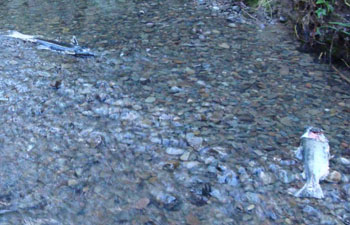 As work was completed on Ryan Creek #2 project in 2012 (read more below), monitoring began to determine the success of the project. Monitors and local residents were delighted to report that fish are now to be found in the upper reaches of the creek, an area where no fish have been seen for 50 years. As work was completed on Ryan Creek #2 project in 2012 (read more below), monitoring began to determine the success of the project. Monitors and local residents were delighted to report that fish are now to be found in the upper reaches of the creek, an area where no fish have been seen for 50 years.
The immediate success of this project is thanks to the project partners who made this fish-homecoming story possible:
1/22/14: Ryan Creek #2 completed
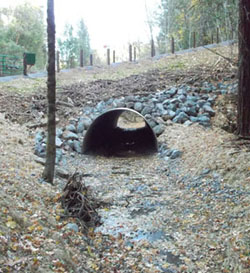 This project is part of a larger cooperative effort by Mendocino County and the Five Counties Salmonid Conservation Program (5C) to protect, maintain and restore anadromous salmonid habitat and water quality while also enhancing public infrastructure. This project will combine benefits with the improved crossing on Ryan Creek Road by Mendocino County and a future project on State Highway 101 to be completed by Caltrans. This project is part of a larger cooperative effort by Mendocino County and the Five Counties Salmonid Conservation Program (5C) to protect, maintain and restore anadromous salmonid habitat and water quality while also enhancing public infrastructure. This project will combine benefits with the improved crossing on Ryan Creek Road by Mendocino County and a future project on State Highway 101 to be completed by Caltrans.
This project has restored access to high quality spawning and rearing habitat and restored fairly natural hydraulic function and watershed processes in an important coastal watershed for the federally listed species. Before removal in 2013, the 5’ metal culvert on Ryan Creek at the Rhine Driveway, effectively blocked access to approximately 1.34 miles of anadromous fishery habitat. The 5’ metal culvert with 5’ overflow culvert with an approximate 1.5’ jump was replaced with a 14’ x 12’ multi-plate arch.
The full stream simulation design complies with the NMFS Guidelines for Salmonid Passage at Stream Crossings (September 2001 as amended), allowing for the 100-year flood flows and associated bedload and debris to pass safely through the new culvert.
For more information, read the final report and view the project photolog
12/31/12: RYAN CREEK #1 (Mendocino County)- Ryan Creek Road Migration Barrier Removal Project- completed
Ryan Creek, a tributary to Outlet Creek, which is a tributary to the Eel River is one of the longest migrations made by Coho salmon in California. This project removed a concrete box culvert with a jump at the outlet that prevented fish from moving upstream and replaced it with a larger “stream simulation” arch structure. Fish removal at the outlet pool relocated approximately 600 Coho salmon and Steelhead trout, while no Coho were found upstream.

Large trees removed from the fill over the box culvert will be moved upstream and downstream to create numerous small pools and provide cover for fish.
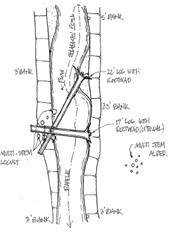 
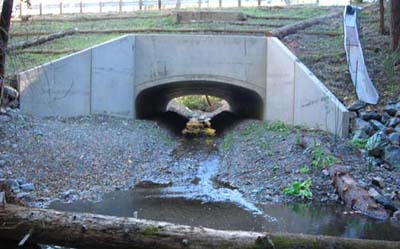
See more Ryan Creek images at our Featured Project Gallery.
10/31/11: Caspar Creek Design Recognized:
The design team for the Caspar Creek Barrier Removal Project led by Winzler-Kelly Consulting, received the American Society of Civil Engineers (ASCE) Statewide (Region 9) Outstanding Environmental Project Award in March 2011. The 5C Program, via a California Coastal Conservancy grant, funded design of the project and provided project, team and timeline management. Another Conservancy grant funded portions of project construction (refer to Enews Four & Five for more on the project). Congratulations to project partners- California Coastal Conservancy, Winzler & Kelly, California Department of Fish and Wildlife, National Marine Fisheries Service, California Department of Forestry and Fire Protection (CalFire) & US Forest Service Pacific Southwest Research Station-Redwood Sciences Laboratory.

The American Society of Civil Engineers (ASCE) represents 130,000 members of the civil engineering profession worldwide, and is America's oldest national engineering society. The Caspar Creek project is located in the Jackson Demonstration State Forest, Mendocino County.
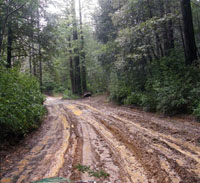 10/31/11: USAL Creek - Usal Road Sediment Reduction Project – Part 1 Construction Begins September, 2011 10/31/11: USAL Creek - Usal Road Sediment Reduction Project – Part 1 Construction Begins September, 2011
The Usal Road project represents a unique opportunity to experiment with geo-textile fabric and varying depths of base rock in combination with road drainage and woody material treatments. The cost and effectiveness of various treatments will be studied and results presented in a paper. If proven effective, additional Road BMP’s may be developed.
Mendocino and Humboldt Counties have historic road segments that due to their original design, placement, and maintenance practices that over the past 100 years have left them with deep through-cut segments that can not be effectively drained. Within these through-cut areas seeps, hillslope drainage, and rainfall are concentrated onto the road surface which then acts like a stream channel and bog. Saturated road surfaces deform and rut quickly and grading to remove the ruts requires deepening of the cuts even further. Many of these through cut have been exacerbated by the lack of local, affordable, permitted rock sources to surface roads to reduce rutting (in these areas rock often sinks, becoming ineffective in a few years).
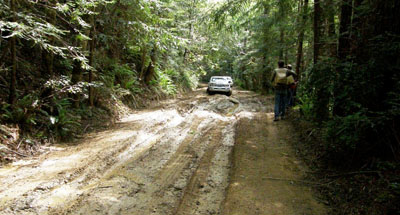
Image of "the bog" on Usal road before treatment

Image of "the bog" after treatment including raising road bed, outsloping for drainage and rolling dip.
This project proposes to use a design/build process to test and implement several techniques within a two mile stretch of Usal Road, Mendocino County Road #431. The design/build treatments will be monitored this winter and spring to test their effectiveness for possible application on up to 50 miles of County roads with large segments of through cuts.
Back to news index.
For more information contact us.
The 5C Enews is funded through the Fisheries Restoration Grant Program through the CA Department of Fish and Wildlife
Image of Chinook Fry at top of page courtesy of USFWS & Dan Cox
| 